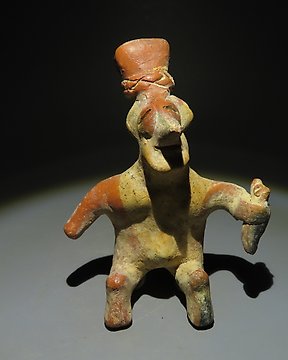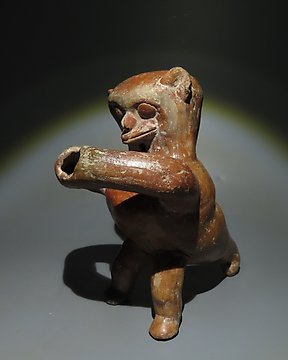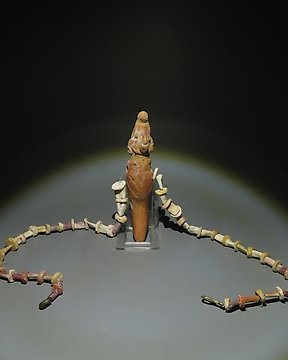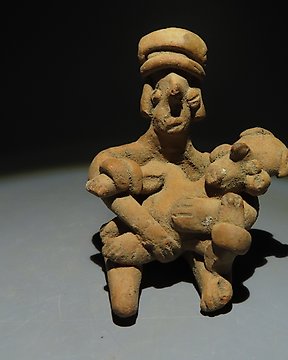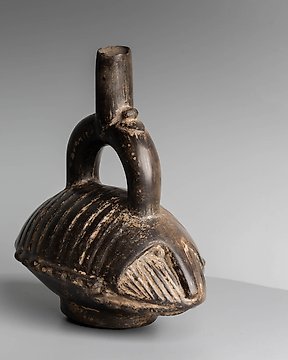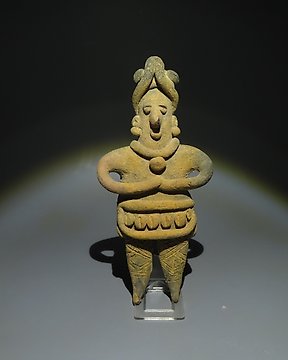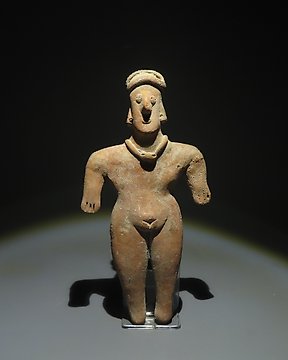All OK and with very fast shipping.
Zobacz tłumaczenieMajowie Terakota zdobiona miska. 650 - 800 n.e. 15 cm D. Hiszpańska licencja eksportowa.
Nr 84860789
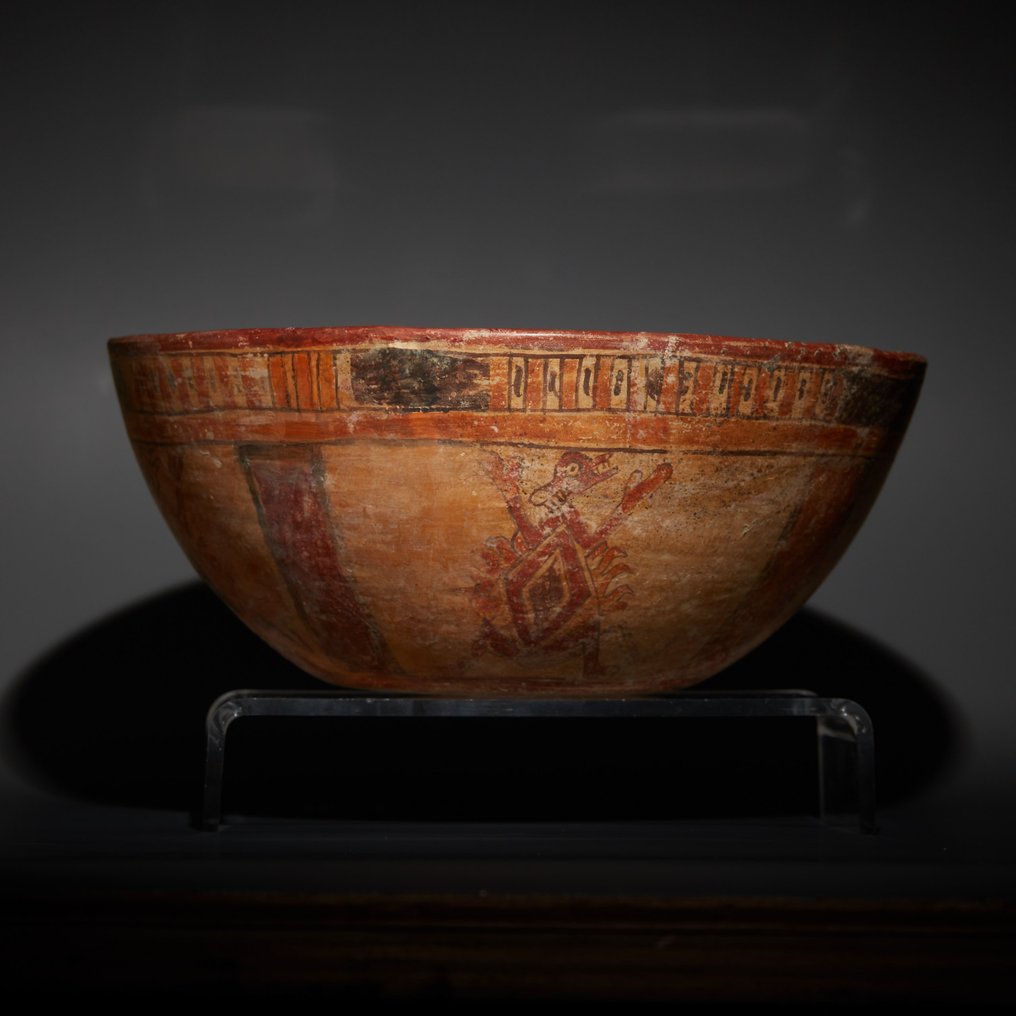
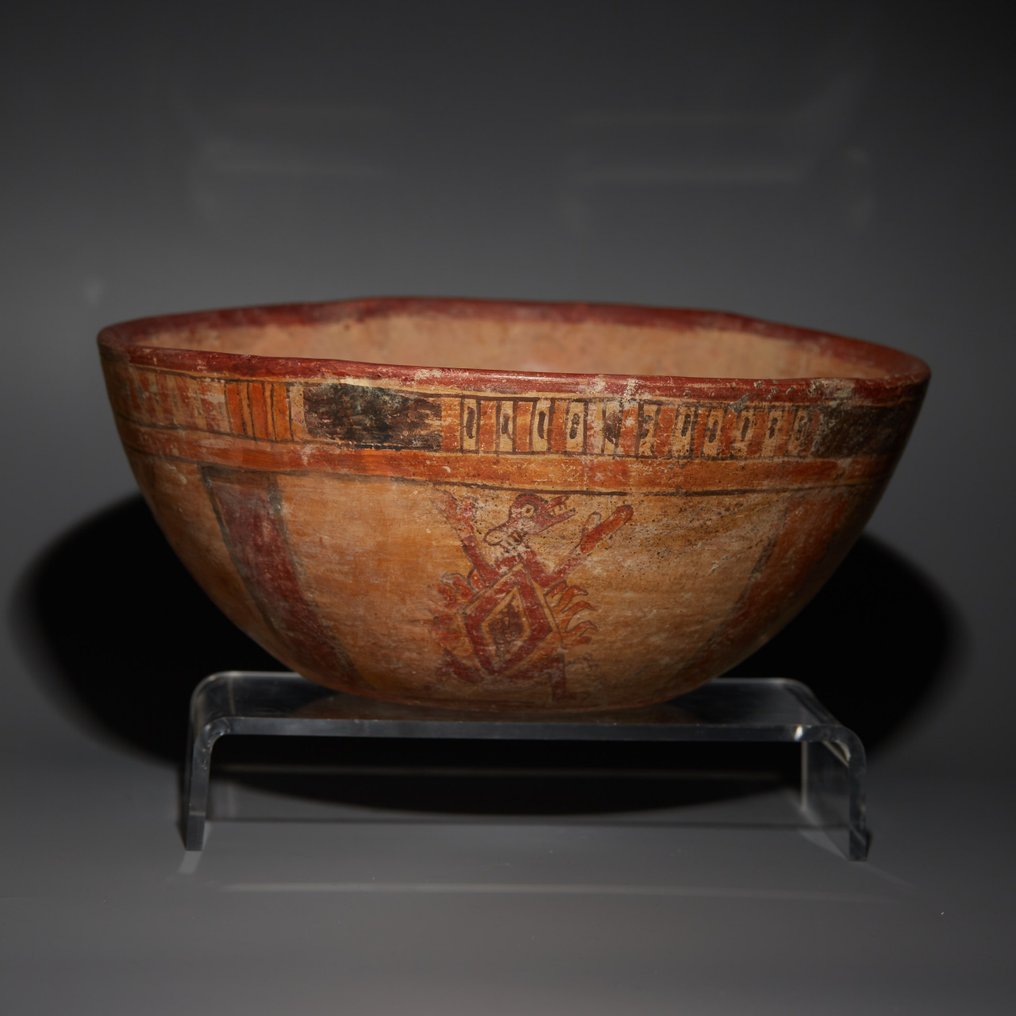
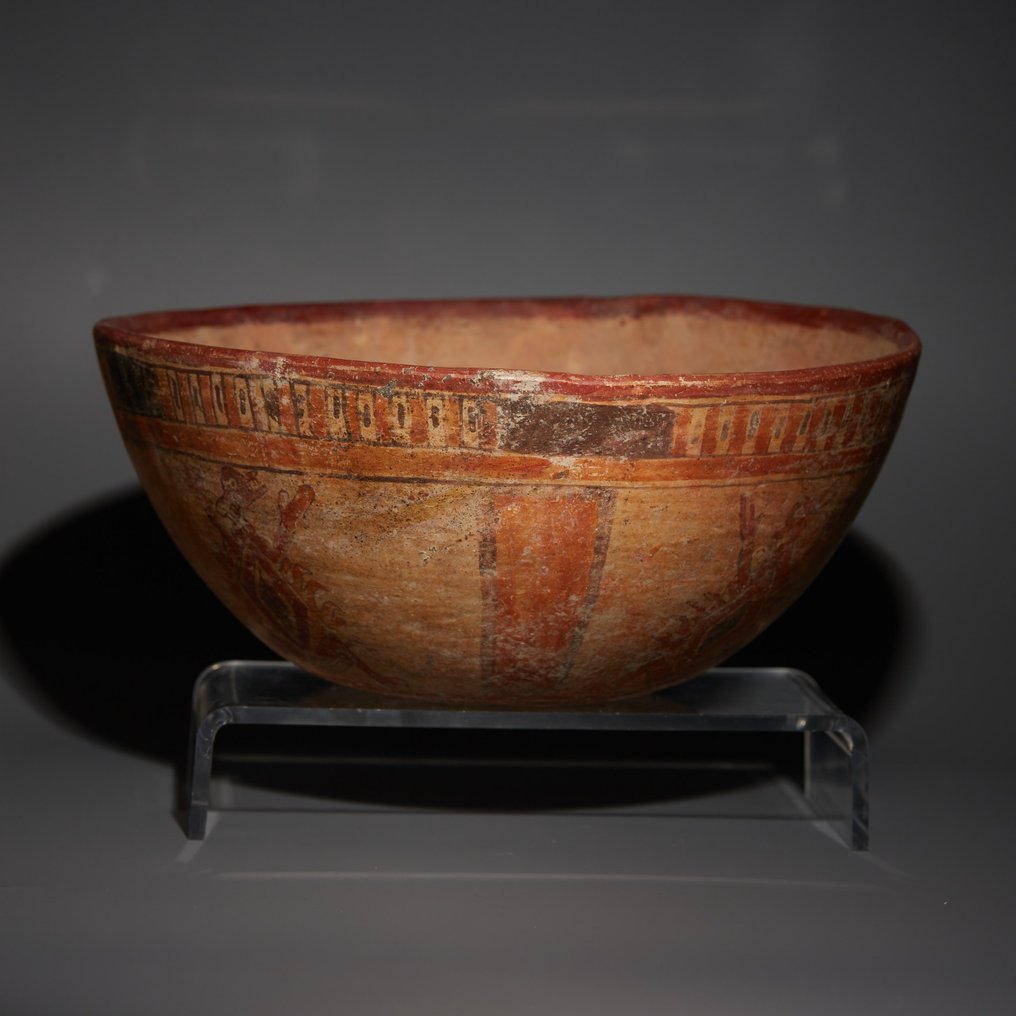
Bowl.
Maya, 650 - 800 AD
Terracotta.
15 cm diameter.
PROVENANCE: Private collection of Mario Villa (1953 - 2021). Mario Villa is known as a collector, artist, designer and furniture manufacturer in New Orleans, United States of America.
CONDITION: Good condition. Repaired from the original fragments.
DESCRIPTION:
The Mayan culture developed from earlier groups of village dwellers and farmers that lived the area and participated in the trade network. They also were influenced by groups living in what is now central Mexico, mainly the Olmecs. Around the 10th Century CE, lack of rain, ecological deterioration and social unrest resulted in the abandonment of the Mayan’s large urban centers. Later, groups of Mayan origin settled on the Yucatan Peninsula where they joined with other groups from central Mexico, mainly Toltecs, to build new civic and ceremonial centers such as Chichén Itza and Mayapán, which remained active until the arrival of the Spaniards in 1525. Today, the descendants of these ancient Mayans still live in the area that stretches from the Yucatán Peninsula to Honduras, where they continue their way of life, wear traditional clothing and speak the language handed down to them by this ancient American culture.
The Maya civilization extended over a large area, from present-day south-central Mexico to Guatemala and Honduras. The area has three distinct geographic regions—the mountains and highlands, the tropical jungle lowlands, and the lowlands of the Gulf of Mexico and the Yucatan Peninsula—each with its own landscape and natural resources. During the Classical Period, the Mayans lived in the highlands and lowlands, in which Tikal and Kaminaljuyú were their major population centers, respectively.
The Mayans developed a unique artistic style with a degree of complexity that rivals that of European baroque. Their extremely life-like, anatomically proportionate human images are found in natural poses that emphasize movement. Their art represented sacred, ritual and hierarchical themes, although they also reproduced scenes from daily life and images of local fauna such as monkeys, tapirs, jaguars, bats, quetzal birds, fish and turtles. Stone was one of their favorite media, and they used it for their buildings, stelas, and the low- and high-relief sculptures that adorned their buildings. The Mayan’s architectural contributions include the stela-altar, the arch and the false vault. In addition to monumental art they also had a highly developed personal esthetic, manufacturing ear ornaments, pendants, necklaces, masks and other adornments out of jade. They deformed their craniums and noses and hung ornaments on their foreheads to make them squint-eyed.
They decorated their pottery with painted and engraved images, producing some of the finest works of pre-Columbian art. Popular Mayan ceramic pieces included serving bowls, pipes and vases, the last of these often adorned with Mayan glyphs.
Notes:
- The piece includes authenticity certificate.
- The piece includes Spanish Export License.
- The seller guarantees that he acquired this piece according to all national and international laws related to the ownership of cultural property. Provenance statement seen by Catawiki.
Historie sprzedawców
Bowl.
Maya, 650 - 800 AD
Terracotta.
15 cm diameter.
PROVENANCE: Private collection of Mario Villa (1953 - 2021). Mario Villa is known as a collector, artist, designer and furniture manufacturer in New Orleans, United States of America.
CONDITION: Good condition. Repaired from the original fragments.
DESCRIPTION:
The Mayan culture developed from earlier groups of village dwellers and farmers that lived the area and participated in the trade network. They also were influenced by groups living in what is now central Mexico, mainly the Olmecs. Around the 10th Century CE, lack of rain, ecological deterioration and social unrest resulted in the abandonment of the Mayan’s large urban centers. Later, groups of Mayan origin settled on the Yucatan Peninsula where they joined with other groups from central Mexico, mainly Toltecs, to build new civic and ceremonial centers such as Chichén Itza and Mayapán, which remained active until the arrival of the Spaniards in 1525. Today, the descendants of these ancient Mayans still live in the area that stretches from the Yucatán Peninsula to Honduras, where they continue their way of life, wear traditional clothing and speak the language handed down to them by this ancient American culture.
The Maya civilization extended over a large area, from present-day south-central Mexico to Guatemala and Honduras. The area has three distinct geographic regions—the mountains and highlands, the tropical jungle lowlands, and the lowlands of the Gulf of Mexico and the Yucatan Peninsula—each with its own landscape and natural resources. During the Classical Period, the Mayans lived in the highlands and lowlands, in which Tikal and Kaminaljuyú were their major population centers, respectively.
The Mayans developed a unique artistic style with a degree of complexity that rivals that of European baroque. Their extremely life-like, anatomically proportionate human images are found in natural poses that emphasize movement. Their art represented sacred, ritual and hierarchical themes, although they also reproduced scenes from daily life and images of local fauna such as monkeys, tapirs, jaguars, bats, quetzal birds, fish and turtles. Stone was one of their favorite media, and they used it for their buildings, stelas, and the low- and high-relief sculptures that adorned their buildings. The Mayan’s architectural contributions include the stela-altar, the arch and the false vault. In addition to monumental art they also had a highly developed personal esthetic, manufacturing ear ornaments, pendants, necklaces, masks and other adornments out of jade. They deformed their craniums and noses and hung ornaments on their foreheads to make them squint-eyed.
They decorated their pottery with painted and engraved images, producing some of the finest works of pre-Columbian art. Popular Mayan ceramic pieces included serving bowls, pipes and vases, the last of these often adorned with Mayan glyphs.
Notes:
- The piece includes authenticity certificate.
- The piece includes Spanish Export License.
- The seller guarantees that he acquired this piece according to all national and international laws related to the ownership of cultural property. Provenance statement seen by Catawiki.
Historie sprzedawców
- 754
- 6
- 0
Prachtig schilderij. Zo blij mee. Zeer nette verkoper en zeer snelle levering.
Zobacz tłumaczenieperfect ! very fast and high quality delivery !
Zobacz tłumaczenieAll well! Thanks.
Zobacz tłumaczenieVendeur très professionnel, top +++×
Zobacz tłumaczeniePhotos trop contrastées pour bien percevoir les défauts, mais ces défauts étaient visibles pour autant. Le "Bon état" est trompeur. Sinon, envoi rapide et correctement emballé. Frais de port exagérés.
Zobacz tłumaczenieGreat communication, delivery and product. Came with a well made certificate of authenticity and good packaging. Overall very happy with the purchase! Delivery is a bit expensive, but I recommend it
Zobacz tłumaczenieMagnifique témoin du passé, envoyé avec tous les justificatifs, impeccable. Encore une fois très satisfait, un grand merci
Zobacz tłumaczenieThank you for the Special offer and the fast shipping of this excellent piece of art!
Zobacz tłumaczenievery good description of the object, very good price for this rare item,. Fast sending (has been at my place 2 days after buying!). Definitely would buy again.
Zobacz tłumaczenieSehr schön
Zobacz tłumaczenieAs described, perfect logistic
Zobacz tłumaczeniegreat seller, everything came as should with certificate of authenticity
Zobacz tłumaczenieExceptionally well packaged, description aligned with positing received
Zobacz tłumaczenieReally precious, but without sound...
Zobacz tłumaczeniePainting well packed and rapidly sent!
Zobacz tłumaczeniesempre grande rapidità e professionalità
Zobacz tłumaczenieparfait bien reçu, merci
Zobacz tłumaczenieVery satisfied with the small Greek Lekythos. As always (we have already bought several items from Bagot), the object was wrapped and sent immediately and with the greatest care.
Zobacz tłumaczeniePerfect, excellent condition, good packaging, the parcel arrived without any problems… all is perfect as usual. Thank you very much and wait for an other nice piece like this one. Gilles.
Zobacz tłumaczenie+++ Top vendeur professionnel comme d'habitude
Zobacz tłumaczenieEmbora o custo de transporte esteja acima da média foi, realmente, muito bem executado e em embalagem cuidada. Expeditos e profissionais. Recomendo
Zobacz tłumaczenieSnel en correct en goed verpakt verzonden
Zobacz tłumaczenieoggetto bellissimo, fedele alla descrizione, venditore affidabile
Zobacz tłumaczenieVery nice piece and fast delivery
Zobacz tłumaczenie- 754
- 6
- 0
All OK and with very fast shipping.
Zobacz tłumaczenie
